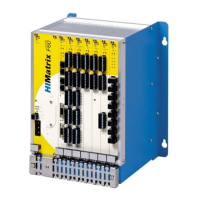System Manual Modular Systems 7 Start-Up
HI 800 191 E Rev. 2.02 Page 67 of 114
Examples of permitted configurations ...
Table 36: Configuration of Pulsed Outputs
The corresponding inputs can be freely selected, i.e., two consecutive pulsed outputs need not
be assigned to two adjacent inputs.
Restriction:
Two adjacent inputs may not be supplied from the same pulse to prevent crosstalk.
7.3.5.3 Configuration Example with SILworX
Fundamental Method for Assigning Variables
In SILworX, the global variables previously created in the Global Variable Editor are assigned to
the individual hardware channels.
Assigning hardware channels global variables
1. Select Hardware in the structure tree of the project.
2. Right-click the input module and select Detail View from the context menu.
3. Change to the DI XX: Channels tab.
4. Drag the global variables onto the inputs to be used.
5. To assign the variables to the outputs, select the corresponding output module and proceed
as described for the inputs.
The hardware channels are assigned global variables.
The following example is based on the list provided in Table 33 and the procedure described
above.
Configuring Pulsed Outputs and Connecting them to the Inputs
The following table shows the connection of the system variables in the input module's Detail
View to global variables:
DI Number of Pulsed Outputs
Pulsed output [USINT] -> consecutive
channels from Sum_Pulse (4)
Table 37: Connection of the Global Variables to Output System Variables of the Input Module
Digital inputs (pulsed channels) may be arbitrarily connected to the pulsed outputs depending
on the hardware configuration.
Connecting the Variables to the Inputs and Corresponding Error Codes
Each input channel value -> Value [BOOL] contained in the DIxx: Channels tab located in the
input module's Detail View is allocated the corresponding error code -> Error Code [BYTE]. The
error code must be evaluated in the user program.

